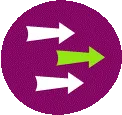Ready or not, the bank of the future is taking shape
Blog: Capgemini CTO Blog
As banks are compelled to offer better, more relevant customer experiences, we see the resultant impact on business models, platforms and the competitive product landscape. Throughout our upcoming blog series, we will examine the implications of this new environment and determine how banks can respond.
An environment of fundamental change
Change drivers vary by region. In the Asia Pacific, the strength of big platforms (AliPay, WeChat) is bolstering new banking models. In India, regulation has opened the market to new competitors such as Paytm, while in Europe, regulatory initiatives such as open banking and PSD2 are imposing a new environment and broadening access to third-party players. In North America, tech giant platforms (Google, Apple, Facebook, Amazon: GAFA) and substantial FinTech investments are pressuring banks to consider new services and models.
Technology is also on the move as computational power exponentially expands to enable vast amounts of data to be managed and processed in near-real time. The result? An ongoing stream of disruptive technologies―ranging from artificial intelligence (AI) and machine learning (ML) to augmented and virtual reality to the Internet of Things and blockchain―are making the reimagining of business models possible. The banking industry is beginning to explore changes introduced by trendsetters Uber and Airbnb and embraced by media, telecom, retail, and consumer goods.
On-demand versus destination banking
 The theme across all regions and areas of change is recognition that today’s consumers expect more from financial services. They demand digital-age services to come to them and to be relevant to their contexts. They no longer accept banking as a stand-alone destination. And when consumers lead small businesses, large corporations eventually follow. Therefore, to retain consumer loyalty, each banking experience must be highly competitive or must plug into a customer’s experience, becoming transparent as a result.
The theme across all regions and areas of change is recognition that today’s consumers expect more from financial services. They demand digital-age services to come to them and to be relevant to their contexts. They no longer accept banking as a stand-alone destination. And when consumers lead small businesses, large corporations eventually follow. Therefore, to retain consumer loyalty, each banking experience must be highly competitive or must plug into a customer’s experience, becoming transparent as a result.
This customer-centric approach encourages reevaluation of the ways by which products and services are delivered and paid. For example, Swedish bank Klarna is redefining payment solutions by offering e-commerce site users different financing options to complete online store purchases. Klarna’s core service is to assume stores’ payment claims while handling customer payments, thus eliminating risk for sellers and buyers. Meanwhile, at Amazon’s cashier-less stores, shoppers scan their phone as they enter and the store’s technology tracks what they pick up and charges them after they leave. The stores analyze purchases through computer vision, ML algorithms, and sensors.
As the innovative FinTech community relentlessly pokes holes in old models, industry practices are converging. For instance, retail shopping  and retail banking practices are coming together as financial services become embedded in the shopping experience to eliminate traditional point-of-sale events. The regulatory environment adds another dynamic to sector convergence. Yet, symbolic of this model-melding trend is the 2017 launch of Orange Bank, which illustrates the realization of an improbable opportunity as a bold French telco followed the trailblazing lead of MPesa (Vodafone), a Kenyan mobile phone-based money transfer, financing and microfinancing service.
and retail banking practices are coming together as financial services become embedded in the shopping experience to eliminate traditional point-of-sale events. The regulatory environment adds another dynamic to sector convergence. Yet, symbolic of this model-melding trend is the 2017 launch of Orange Bank, which illustrates the realization of an improbable opportunity as a bold French telco followed the trailblazing lead of MPesa (Vodafone), a Kenyan mobile phone-based money transfer, financing and microfinancing service.
The bank as an ecosystem
 Historically, traditional banks operated as a closed shop protected by sturdy physical or digital doors. It’s no surprise, then, that today’s demands for change require a fundamental shift in operational and technological thinking.
Historically, traditional banks operated as a closed shop protected by sturdy physical or digital doors. It’s no surprise, then, that today’s demands for change require a fundamental shift in operational and technological thinking.
The starting point is enthusiastic acceptance of an API-led economy so that banks and third parties can align through plug-and-play services. This services-and-third-parties model raises a few questions, however. What should the bank own? What should it connect with? What should it buy, and what should it build? Astute answers address how to avoid the containment of fixed models and costs, while considering the advantages of as-a-service models―SaaS, PaaS, or public cloud, IaaS.
Digital customer touchpoints are making paper-processing obsolete and straight-through processing the norm. Complex tasks are now simplified through AI and ML so that real-time decisions and analysis of risk and fraud are accomplished through extensive data sets not previously available. Where a bank used to have hundreds of physical locations, thousands of employees, and considerable fixed costs, we now see models with comparable numbers of customers that are unrestricted by physical site, run by a handful of staff, and offering everything as a service.
The successful banking model of the future will feature a platform that flexibly engages with the customer’s dynamic ecosystem of services. However, this model will require the bank also to become an ecosystem that can nimbly plug and play new services and components to meet changing customer demands. New skills and mindsets will be required to navigate in this new world.
Reimagining banking products
Traditional products were defined and constrained by each bank’s core systems (current accounts, cards, and mortgages). However, to meet dynamic new expectations, we expect an increased emphasis on speed of change, personalization, and bundling (bank-owned products with 3rd party products) to create new offers. The telco industry has achieved rapid product evolution and bundling while retaining sizeable back-end transaction-processing platforms.
Clearly, product reimagining is a fundamental change to the banking core. In the previous model, services focused around high-integrity transaction processing and ledger management. In the new model, core platforms must be disaggregated into services, separating out transaction processing from product and customer management. The new model will spur new product-management and bundling platforms to operate independently of core ledgers, which will become real-time utility services, not reliant on the batch models still standard in many areas.
At one extreme, blockchain and distributed ledger technology will enable a wholly-distributed version of this model. However, less radical and proven platforms are already available to support a utility model using cloud-based packages (Temenos on Amazon Web Services) or cloud-native full-stack builds from challenger banks (Starling). Given the existing operational and technological infrastructure, as well as historic capital investment, the challenge for banks today is how to transition into a bank of the future effectively.
A test-and-learn journey
Banking transformation is not about moving from point A to point B. Today’s accelerated pace of change means that by the time a bank  makes a move, the context may have shifted. Therefore, the key to long-term success is an internal culture capable of continuous change. The emergence of initiatives such as innovation labs, agile, BizDevOps, and enterprise agile indicate that the culture change movement is already taking hold. The end game includes the move away from cumbersome proposition design and preparation to a test-and-learn model.
makes a move, the context may have shifted. Therefore, the key to long-term success is an internal culture capable of continuous change. The emergence of initiatives such as innovation labs, agile, BizDevOps, and enterprise agile indicate that the culture change movement is already taking hold. The end game includes the move away from cumbersome proposition design and preparation to a test-and-learn model.
Successful growth is no longer about adding a digital business at the edge of the organization. Instead, it’s about realigning a customer-centric organization while managing the regulatory, commercial, and risk dimensions unique to financial services. Challenger banks are unfettered by legacy and can start in the new model, scaling at pace. So, however daunting, there is no choice for incumbents but to embrace today’s business parameters and success criteria.
Coming up …
 Leading up to the September 18 launch of the World Retail Banking Report 2018, we will publish a blog series that takes a close-up look at three pivotal banking topics: Customer Experience and Business Models, Technology and Operations, and Product Management. Stay tuned for insights and practical advice about transformation and the new normal for retail banking. Or, to learn more about Capgemini banking solutions, visit www.capgemini.com/service/retail-banking.
Leading up to the September 18 launch of the World Retail Banking Report 2018, we will publish a blog series that takes a close-up look at three pivotal banking topics: Customer Experience and Business Models, Technology and Operations, and Product Management. Stay tuned for insights and practical advice about transformation and the new normal for retail banking. Or, to learn more about Capgemini banking solutions, visit www.capgemini.com/service/retail-banking.